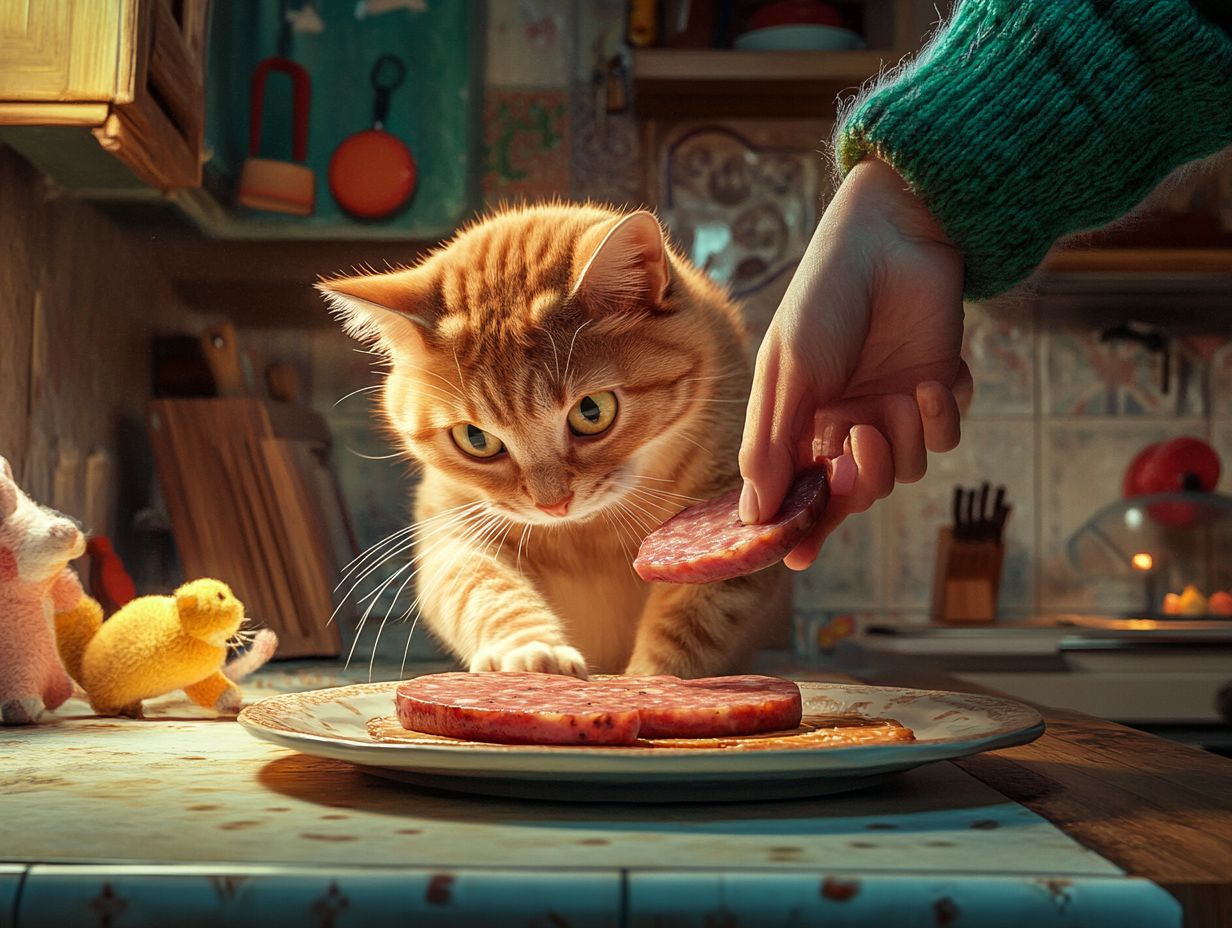Cats are curious creatures, often eyeing our meals like cooked chicken or fish with interest. But when it comes to sharing food, human favorites like bacon and sausage aren’t always safe for our feline friends.
This article explores a cat’s unique dietary needs and whether sausage is a suitable treat. It uncovers the potential risks and benefits of feeding sausage to cats, presents healthier alternatives with specific portion sizes, and shares essential tips for safely introducing new foods.
Let’s explore how to keep your cat’s diet safe and healthy!
Key Takeaways:
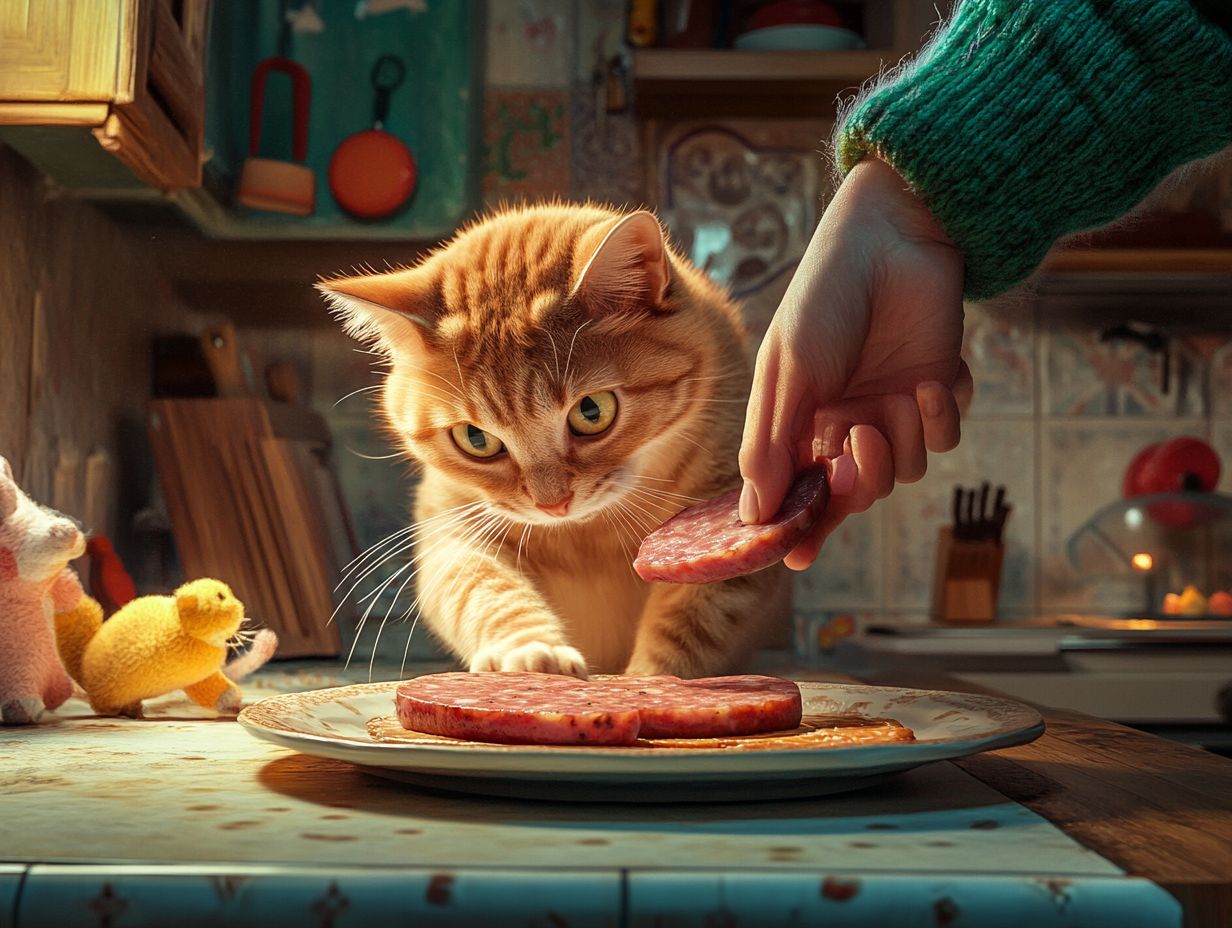
- Cats have specific nutritional needs and restrictions, making it important to understand their diet before incorporating new foods.
- Sausage is not recommended for cats due to its high fat and sodium content, but it can provide some benefits like protein and variety in a cat’s diet.
- If you choose to give your cat a taste, limit it to a small piece no larger than a pea. Instead, offer safe and healthy alternatives like lean meats, cooked vegetables, and cat-specific treats.
Nutritional Needs of Cats
Veterinary nutritionists emphasize that understanding a cat’s diet is crucial for its health and well-being, as it significantly affects a cat’s overall condition, weight, and energy levels. Cats primarily need meat in their diet, meaning their diet must primarily consist of animal protein to ensure they receive adequate nutrition.
It is essential to carefully manage cat diets to prevent health issues such as obesity and deficiencies in vital nutrients, including thiamine (Vitamin B1). Therefore, veterinary nutritionists advocate for a diet specifically designed for cats, tailored to their unique physiology and lifestyle needs.
Can Cats Eat Sausage?
Sausage is not recommended for cats due to its high fat and sodium content. For more details, refer to this informative article: Can Cats Eat Sausage? Is It Safe to Feed Cats?.
While certain cooked meats can be a healthy addition to a cat’s diet, sausages are typically high in fat and sodium, which may not be safe for cats, particularly those with pre-existing health conditions such as pancreatitis or obesity.
It’s crucial to be aware of the ingredients in sausage, as some varieties may contain preservatives or unhealthy additives like garlic and onion, which can be toxic to cats. Always check the label for any harmful ingredients.
Potential Risks and Benefits
Sausage can present both risks and benefits in a cat’s diet. While it may provide protein, it often contains trans fats and other ingredients that can lead to obesity, pancreatitis, and bacterial infections such as Salmonella or Listeria.
Here are the risks associated with cats consuming sausage:
- Cats are obligate carnivores and require a diet rich in animal protein, making sausage appear to be a useful addition.
- However, sausage typically contains spices, preservatives, and high levels of sodium, which are not well metabolized by cats.
- Veterinary studies indicate that a cat’s diet must be carefully balanced based on age, weight, and overall health.
- Regular exposure to high-fat diets can result in long-term health issues.
Consequently, there is a trade-off between the short-term benefits of giving cats sausage and the long-term negative effects, particularly since cats have varying dietary requirements.
Alternatives to Sausage for Cats
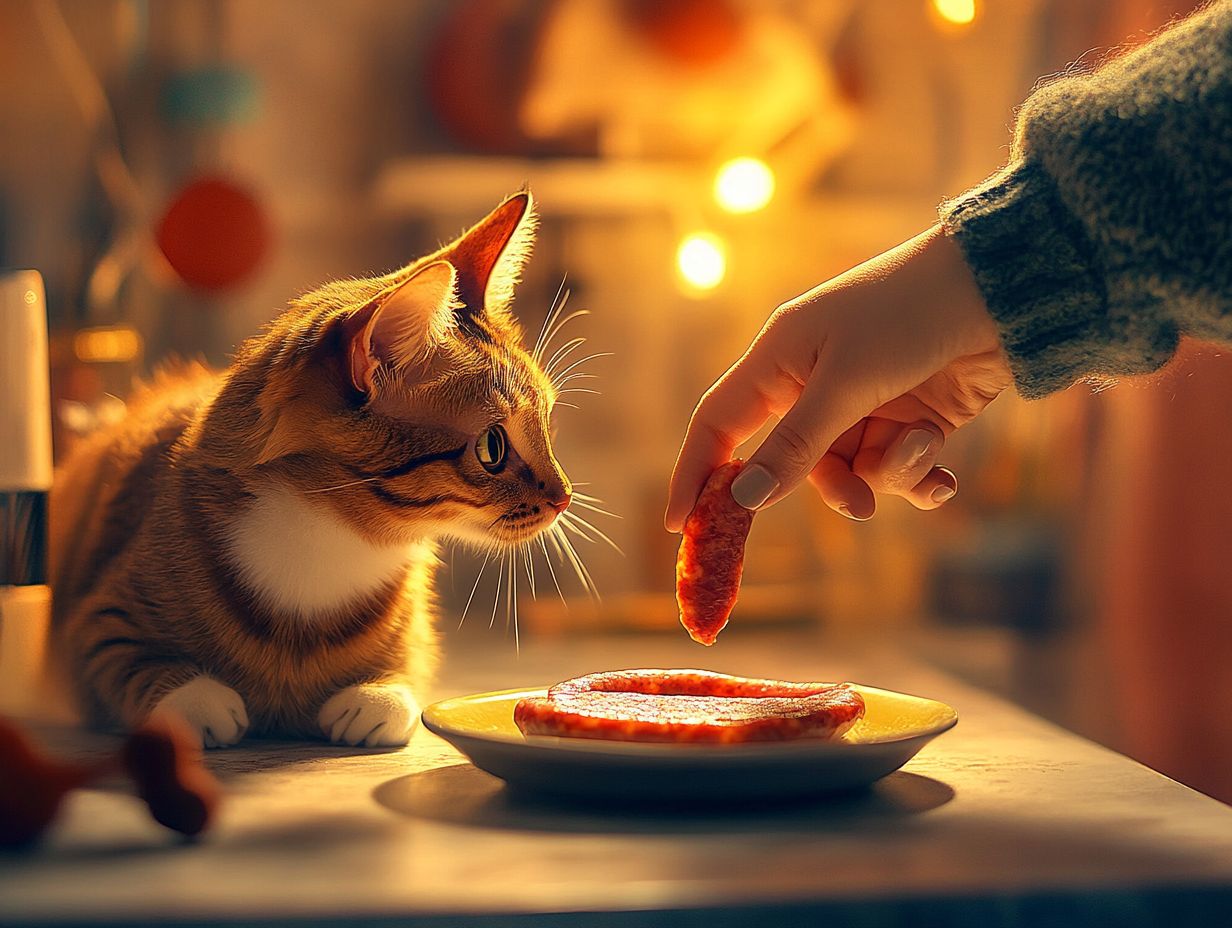
Safe and healthy alternatives to sausage for cats include several options. Cooked meats such as chicken or turkey serve as excellent substitutes, providing essential protein for felines without the high fat and sodium content found in processed meats.
- For chicken, steam it and cut it into bite-sized pieces, serving about 1-2 tablespoons depending on your cat’s size.
- For turkey, ensure it is plain and cooked without seasoning, offering a similar portion size.
- Consider adding small amounts of cooked vegetables like carrots or peas as a snack.
Consulting veterinary nutrition recommendations for cat treats can also assist in selecting safe and nutritious alternatives to sausage.
Safe and Healthy Treat Options
The best cat treats are safe and healthy options that support a cat’s well-being while satisfying their cravings. High-quality animal protein sources, such as cooked chicken, fish, or specially formulated cat treats, offer superior taste and essential nutrients that meet a cat’s dietary needs.
- Consider treats that are low in sodium and free from harmful preservatives, additives, or fillers.
- Options like freeze-dried meat or fish—such as sardines, cod, salmon, shrimp, or chicken—are appropriate choices that provide natural vitamins and minerals.
- Treats that include catnip or pumpkin can aid digestion and provide fiber, while dental treats support oral health.
Owners should carefully review ingredient lists to avoid preservatives or fillers that could harm their cat’s health. Choosing treats that align with a cat’s carnivorous nature is essential not just for preference but also for ensuring a full and balanced life.
Feeding Sausage to Cats: Precautions and Tips
If you choose to feed sausage to your cat, the following precautions should be taken:
- While some cats may enjoy the flavor of sausage, it is important to limit both the amount and frequency of this food. High-fat processed meats can contribute to obesity and related health issues.
- Only provide your cat with small portions of plain, fully cooked sausage that is free from additives.
- Always consult your veterinarian beforehand, particularly if your cat has any known health concerns.
How to Safely Introduce Sausage to a Cat’s Diet
Introducing sausage into a cat’s diet should be done gradually and with caution to prevent any upset stomach. Owners should start by offering their cat a small portion of fully cooked sausage—approximately a teaspoon for cats under 10 pounds—and observing their reaction. It is essential to monitor for any signs of digestive distress, such as vomiting or diarrhea.
If the cat enjoys the sausage and exhibits no negative reactions, the portion can be gradually increased while continually monitoring the pet’s overall health and weight. Owners should also be attentive to any changes in behavior or litter box habits, as these can indicate how well the cat is adjusting to the new food.
Mixing a small portion of sausage with their regular food can help them become accustomed to the taste while ensuring they receive the necessary nutrients. Consulting a veterinarian is advisable to determine the appropriate amount of sausage, if any, that should be given to cats, as well as what other foods it can be paired with. For more details, check out Can Cats Eat Sausage? Is It Safe to Feed Cats?. Products like the PangoVet food bowl can assist in proper food management.
Maintaining an ongoing conversation with a veterinarian will help ensure the long-term health of the pet and minimize any potential negative side effects.
Overall Recommendations and Considerations
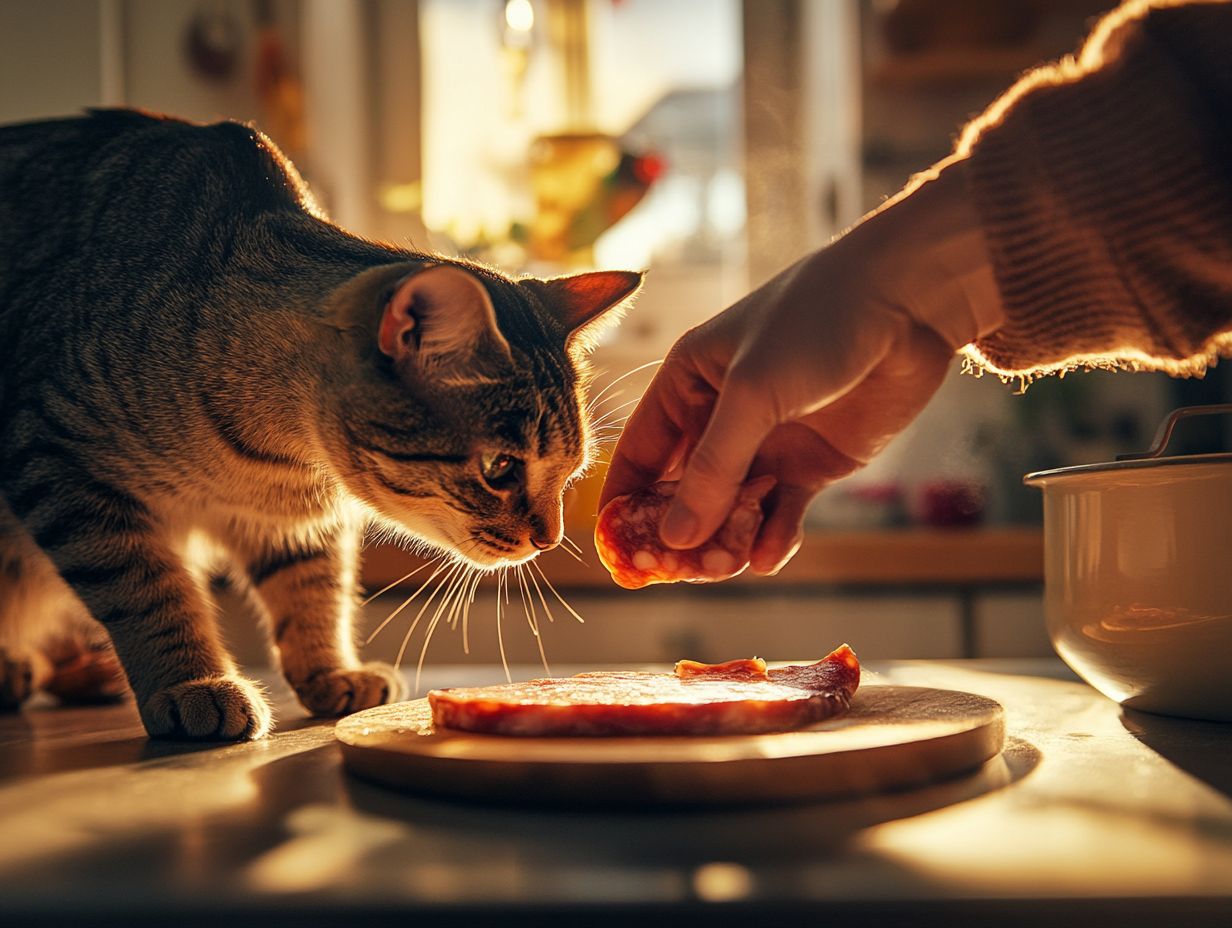
Recommendations for feeding sausage and other treats to cats emphasize the importance of improving health and achieving nutritional balance in their overall diets. While sausage can be a beneficial addition to a cat’s diet, it is essential to weigh the positive effects against the potential negative consequences and ensure that the benefits do not outweigh the risks.
Treats should be given in appropriate amounts to minimize the chance of causing future health problems. Proper care for cats involves not only the occasional offering of treats but also regular monitoring of the long-term effects of these treats on their overall health.
Owners can start by introducing new foods in small quantities and observing for any adverse reactions, such as gastrointestinal issues. Consulting with veterinarians can provide valuable insights into the appropriate amount and frequency of treats, reinforcing the importance of moderation.
By paying attention to how sausage and other diets affect their cats’ health, pet owners can establish healthy eating practices, reduce the risk of obesity and other dietary conditions, and support their cats’ overall well-being. For more detailed insights, see Can Cats Eat Sausage? Is It Safe to Feed Cats?. Websites like PetMD offer valuable insights into feline dietary needs.
Frequently Asked Questions
Can Cats Eat Sausage?
While some cats may enjoy sausage, it is not recommended as a regular part of their diet due to potential digestive issues and health risks.
Is it Safe to Feed Cats Sausage?
Feeding sausage to cats is generally not recommended. It can lead to digestive problems, obesity, and other health concerns due to its high-fat content and the presence of additives in processed meats.
What Types of Sausage are Harmful for Cats?
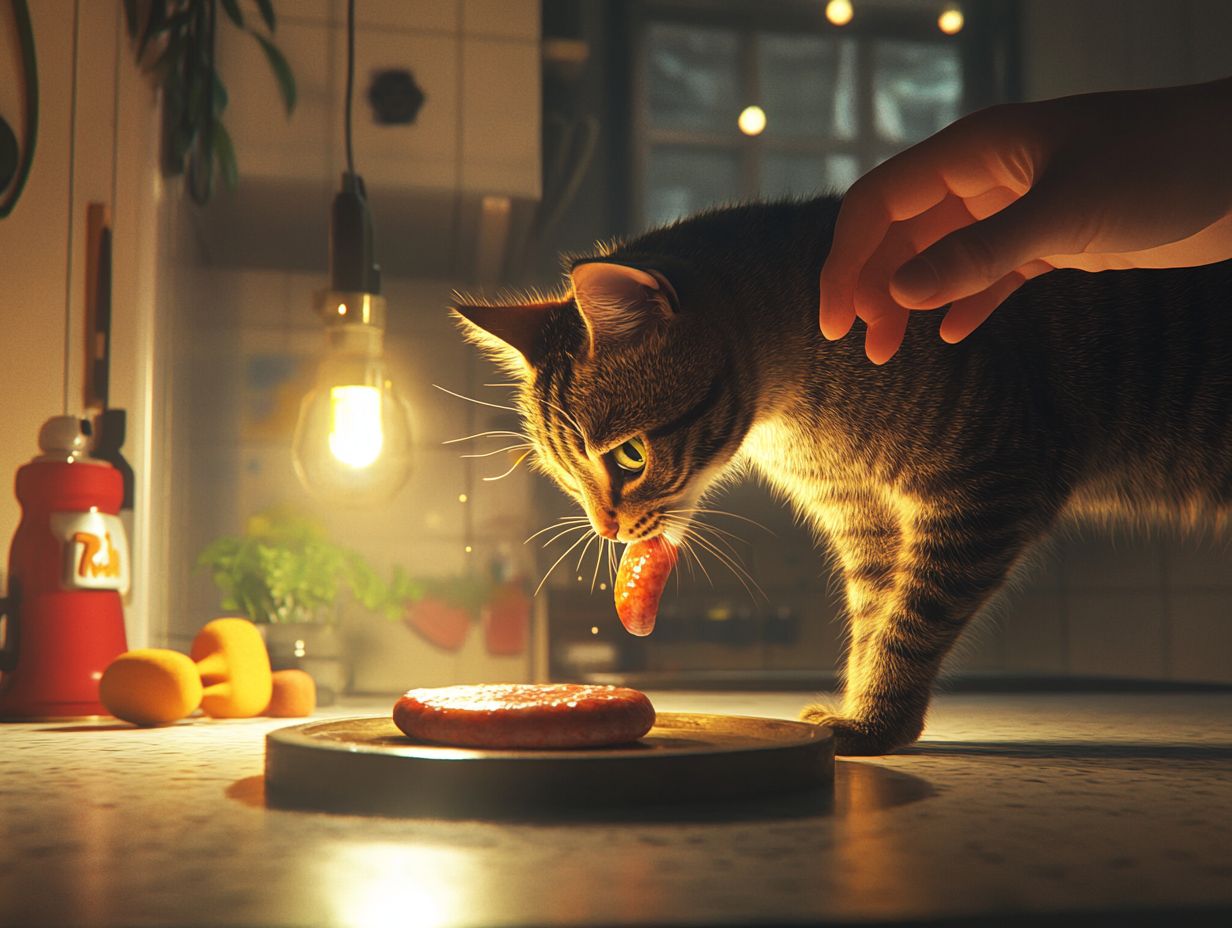
Sausages that contain ingredients such as onions, garlic, spices, preservatives, high levels of sodium, and fat can be harmful to cats. These ingredients pose risks like pancreatitis and obesity due to their high-fat content.
Can Cats Eat Cooked Sausage?
Cats should avoid all types of sausage, cooked or raw, because they do not fit into a healthy feline diet.
What if My Cat Accidentally Eats Sausage?
If your cat accidentally consumes a small amount of sausage, monitor them closely for signs of discomfort or illness, such as vomiting, diarrhea, or lethargy. Sausages may contain harmful bacteria like Salmonella or Listeria. If they show any symptoms, contact your veterinarian or consult PetMD immediately.
What are the Alternatives to Feeding Cats Sausage with Animal Fat?
Cats should stick to their natural diet of high-quality, protein-rich foods such as meat, fish, and specialized cat food. Treats should be given in moderation, and it is important to check ingredient lists to ensure they are safe. Consider brands like Untamed for premium quality. If you want to treat your cat, opt for cat-friendly snacks such as cooked chicken or fish. Additionally, using a Hepper NomNom Cat Bowl can make mealtime more enjoyable. Always consult your veterinarian before introducing new treats to your cat’s diet. For more information on feline nutrition, consult resources like the Cornell Feline Health Center or PangoVet.
Conclusion
In summary, a balanced diet is crucial for feline well-being. Always prioritize high-quality, safe foods for your cat and consult a veterinarian for dietary choices.
